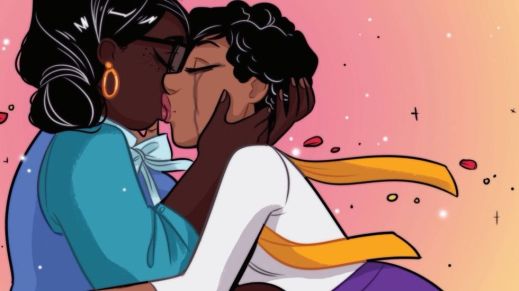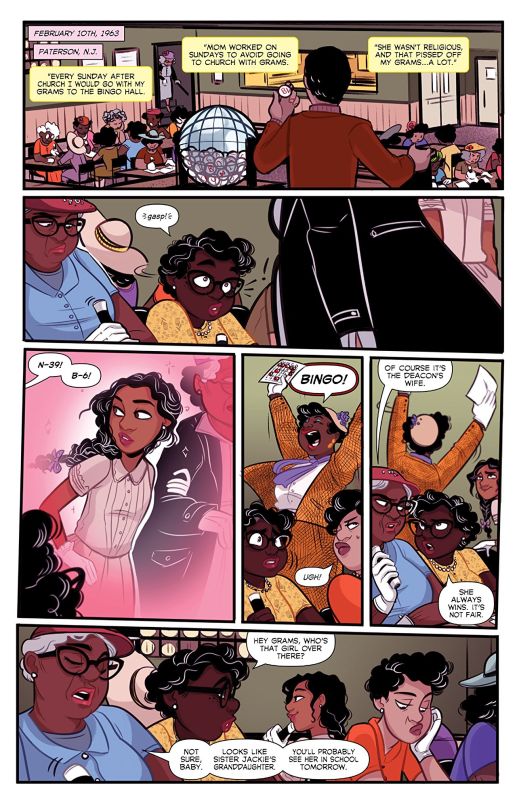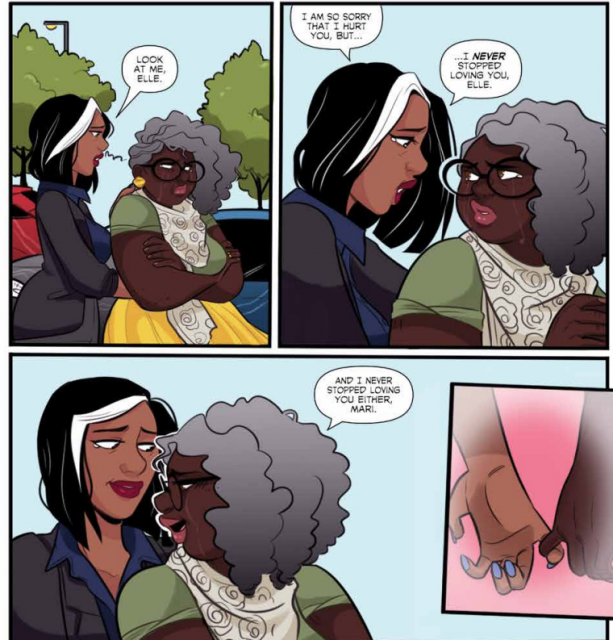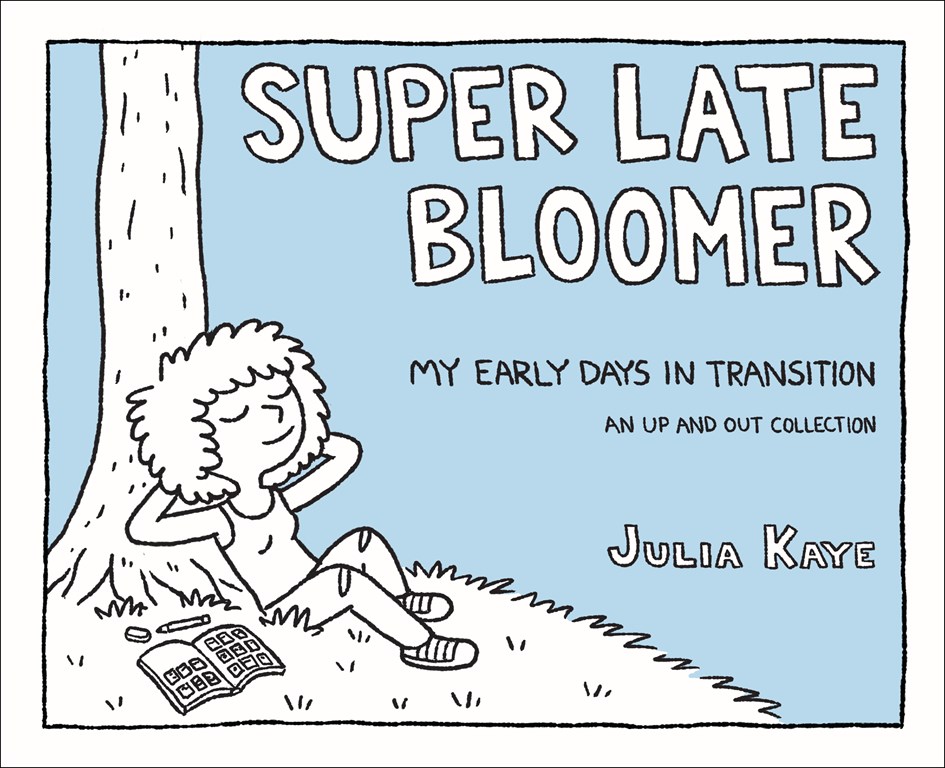“Anger is never constructive.”
This was one of hundreds of quotes that hit me like an eighteen-wheeler when I first streamed Hannah Gadsby’s Netflix comedy special, Nanette. My wonderful girlfriend gushed about it upon her first viewing. “You of all people will adore it,” she frantically texted me. I had seen advertisements for it and watched the trailer and was very much intrigued, so finally, after a night of trudging through online school homework, I fired up Netflix and strapped in.
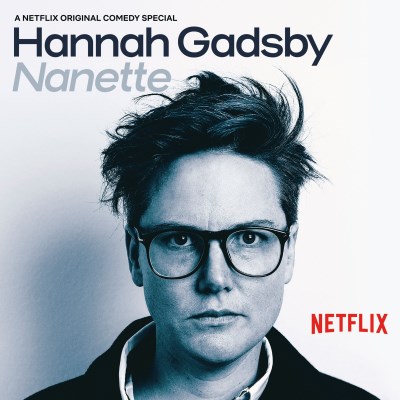
Once the hour of cheering, laughing, sobbing, enthusiastic screaming, and clapping concluded, I immediately took to Facebook and Twitter urging everyone I knew to watch the special. I was blown away by Gadsby’s strength and earnest. The bravery required to stand in front of at least 2,000 people at the Sydney Opera House and brilliantly deconstruct an entire genre of entertainment is immeasurable, and I remain in awe of her wisdom.
Nanette is not simply a comedy special. It is a baptism. It challenges a culture of performers reliant on trauma and tension to sell laughs to adoring crowds. Gadsby’s words are a rally cry of reformation within a system dependent on silencing contrary opinions and experiences. I settled into this special looking to receive some good laughs and insightful social commentary. I left the special wanting to riot in the streets and set fire to fragile patriarchal masculinity.
Gadsby has been fairly popular in Australia for years, performing many different hours and segments of stand-up comedy, as well as making appearances on television shows. Her semi-fictional character named Hannah on Josh Thomas’s Please Like Me was a huge success with audiences. Gadsby’s character struggled with depression and sexual identity. “I’m not acting when I act. I played a fat, depressed lesbian called Hannah,” she said on The Comedian’s Comedian podcast in 2017. This quip was meant as a joke, but as anyone who has seen Nanette could probably attest, we often joke to mask the true traumas of our lives.
After the therapeutic rollercoaster of Hannah Gadsby, I was compelled to watch another important stand-up special that was released around the same time. Rape Jokes, which is the newest hour from comedienne Cameron Esposito, can be streamed for free on her website. Part relentless critique and part memoir, Rape Jokes finds Esposito sharing her own experience with sexual assault, while also brainstorming ways we can shift the culture.
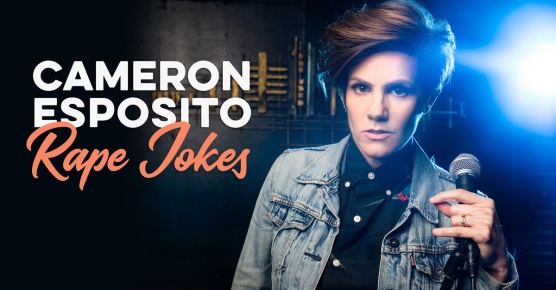
Esposito is a prominent face in LGBTQ+ comedy. She and her partner, Rhea Butcher, created the show Take My Wife, perform stand-up together, and host the podcast Put Your Hands Together. Esposito’s other incredibly popular podcast is her groundbreaking Queery, where she sits down with all manner of queer creators, business owners, activists, etc. and discusses their stories and experiences. As an avid listener, I can attest the positive impact that these conversations have on listeners. She makes sure to be as intersectional and open as possible, bringing on a wide array of guests.
Rape Jokes is, in many ways, like Nanette, but when tackling these similar social issues, they convey different feelings. Something particularly fascinating about Esposito’s special is the way it harnesses classic stand-up delivery to constructively confront sexual assault and the toxic elements of rape culture. Esposito challenges society in a way that’s perhaps more traditional than Gadsby’s radical approach. For the rest of this post, I want to focus on specific aspects and topics from both specials and discuss how intrinsically their messages serve one another, as well as their respective audience. I assert that these specials should be watched and discussed together—not only for the content of their writing, but for the differing ways each performer hones their craft to deliver their messages.

That being said, I’ll begin by talking about the importance of delivery in both specials. Hannah Gadsby is all about timing. Part of her charm is in her laid-back wit. “I identify as…tired,” is a fantastic quip that is delivered with precise pause. Even during her appearances on Please Like Me, Hannah’s lines are delivered with a gentle poise. It’s incredibly endearing and offers a comfort to the audience. This is why it’s jostling when the material of Nanette starts getting serious. It’s as though that comfort is suddenly ripped away like a tablecloth. “This tension is yours,” she yells, “I am not helping you anymore!” Some may view this shift as a “woman getting angry,” but it is so much more.
Nanette is a meditation of the craft of stand-up comedy. She is criticizing the way comics—especially male—have utilized the form of stand-up to “artificially inseminate” tension into a room. Gadsby wants the audience, and even the world, to understand that stand-up is ultimately a construction. It isn’t quite as genuine as many people would like to think. I often wrestle with this when watching specials from my favorite comics. I’ll use Pete Holmes as an example. Pete Holmes is a lovable performer whose delivery feels as warm and genuine as his smiling face. He often describes himself as a “silly-silly-fun-boy” and it shows. As someone who listens to his podcast, I guarantee that most of that warmth is not an act. He does seem like a very genuine, down-to-earth person, but that does not mean that his set is not finely tuned.
There is an illusion that comes with comedy, and I notice it within music as well. Performers are delivering the same set or same material to every state or country they visit. Sure, audiences may receive a few specific jokes or stories concerning their home state, but it’s essentially the same hits every single time. In December, I went to see John Mulaney on the Kid Gorgeous tour. It was hilarious and relatable. It was John Mulaney. His delivery was everything I expected and the stories and bits were irreverent and whacky, but when it came time to experience it again on Netflix, I felt this strange numbness. It was the exact set I saw in Philadelphia, just minus a story about being lost in the city. I’m not saying there’s anything wrong with that, but it did break the spell for me. Much of comedy is a constructed system that is built to elicit the same responses every time.
Hannah’s awareness of this constructed format allows her to harness the craft while ultimately disassembling it. She has a very firm understanding of how comedy works and is “very good” at her job, as she says. This is why the special does such an impeccable job at being both a stand-up special and a meta-takedown lecture all in one. Because of her deep understanding of the craft, she can teach a thousand viewers why this construct can be destructive. But, we will get there. For now, let’s move on to Cameron Esposito’s delivery, because it’s fairly similar to Gadsby’s but harnessed in a different way.
One day, as I was perusing comedy videos on YouTube, I came across some Conan videos of a comedian I would come to love named Cameron Esposito. As I was watching one of her sets on Conan’s show, I saw a video in the related column called “The Greatest Period Joke Of All Time #CHUNKS.” Naturally I was curious, and my love for this brilliant comic became cemented forever. Her delivery is energized and invigorating. When people ask me to compare her to other comics, I often liken her performance to Jim Carrey but add “funnier and with more social commentary.” That is not necessarily meant to discredit some of Carrey’s more engaging work, but Esposito does it way better. She shouts when she needs to, uses funny voices, employs uncomfortably descriptive language; in other words, she’s fantastic.

What’s engaging about Rape Jokes is that her energy appears at an all-time high throughout the hour set. There’s an urgency evident in her delivery and movements. Its introduction is explosive, showing that the performer is holding back none of her punches: “I FEEL, this is just me, that every moment of the current administration is a living nightmare!” This smoothly leads into her focus of sexual assault as Esposito unloads on Trump’s misgivings using her charming wit. While Gadsby discusses self-depreciative humor in her special, highlighting the danger of constantly tearing yourself down at the expense of humor, Cameron Esposito is quite the opposite. Part of what makes her so loveable is the confidence that she carries in her performances: “I’m not an omniscient god, despite how you worship me.” She knows her strengths and weaknesses, and instead of capitalizing on said weaknesses, Esposito reveals them as a tool to help endear herself to the crowd.
Hannah Gadsby uses self-depreciation to prove a larger point that in deconstructing ourselves in such a way, further trauma can manifest:
“Do you understand what self-depreciation means when it comes from somebody who already exists in the margins? It’s not humility, it’s humiliation. I put myself down in order to speak, in order to seek permission to speak. And I simply will not do that anymore—not to myself or anybody who identifies with me.”
Think about any form of public speaking you have done, or dates you’ve been on, or maybe even within a job interview; when we are uncomfortable, or want to make ourselves out to be humbler, we often tear ourselves down as a people. We see it as a tool of endearment, but it rather often comes off as humiliation. Instead of laughter, we insight pity, and that’s not necessarily our aim. In a recent interview with HuffPost Editor-In-Chief, Lydia Polgreen, Gadsby highlights the different gendered reactions to self-depreciative humor: “The difference between Louis C.K. and I is we can both say we’re losers and for me the world says, ‘yeah, you are a bit,’ and when Louis does it, they go, ‘you’re a genius.’ And that’s what pissed me off.” Rightly so, Hannah.
It is through these nuanced performances that both comics tackle the legacy of stand-up comedy. Hannah Gadsby has built herself quite the career as a comic in Australia, but with her first global hit, she announces that she’s “quitting comedy.” Needless to say, my ears perked up as I heard this while streaming Nanette. I had just discovered her work; how could she quit comedy? Yet as the show progresses, it becomes more and more evident as to why this deeply empathic person may not “feel comfortable” within the medium anymore.

One of the best aspects of the special is when she breaks down the idea of comedy into basic ingredients. Within stand-up, there is often tension and then the laughter that breaks the tension. In her words, “tension isolates us and laughter connects us.” When you’re in a crowded theater of people, laughing, that tension flows from your body and encourages ease. The issue then arises that the comic is the one that made you feel that tension, they created it for the audience. This leads to what Gadsby calls an “abusive relationship.” It’s uncomfortably true. Most of the jokes that comedians tell are meant to illicit these types of responses. It’s their job. A joke is essentially a set up, then punchline, or a question that receives a surprise answer.
The other important facet of Gadsby’s thesis on comedy is just how much trauma and tension can harm the comic themselves. Toward the beginning of the show, she tells the story of her mother’s reaction to her coming out. As some can imagine, it wasn’t quite a jump for joy. However, she returns to the subject of her mother revealing that she later apologized. The mother wanted to keep Hannah safe from the world, knowing that her life would be hard and she just didn’t want it to be harder.
Without that ending, Hannah’s story is not complete: “Comedy has suspended me in a perpetual state of adolescence. The way I’ve been telling that story is through jokes. And stories, unlike jokes, need three parts: a beginning a middle and an end.” Jokes typically need the beginning and middle sections to work, because it creates tension: “Punchlines need trauma because punchlines need tension, and tension feeds trauma.” This leads to one of the most profound refrains in the entire show when Gadsby declares, “You learn from the part of the story you focus on. I need to tell my story properly.” It’s hard to enjoy comedy after that. There is this American idea that endures where people feel as though they need to suffer to be able to bring any sort of substance or creativity into the world. That’s just not healthy. Perhaps this thesis explains why so many male comics appear as juveniles running around on the playground. There is no growth in telling the same joke about your wife for the umpteenth time. There is no growth in proclaiming the word “rape” to a crowded room of people, yet the jokes continue (yeah, I’m looking at you, Daniel Tosh).
Cameron Esposito is no stranger to the “shock-jock” type of comedy. In a brilliant sequence from Take My Wife, Matt Braugner plays a Tosh-esque male comedian delivering a very tasteless rape joke while Esposito and Butcher watch from side stage. Braugner says, “If this year has taught us anything, it’s that society will not believe that a woman’s been raped unless 48 other women claim they were raped by the same guy. That’s why I only raped 47.” Yikes. There’s a lot to unpack there, but the main issue lies in how that character utilized sexual assault in the joke. Many male comics use sexual assault to make their jobs easier. If you talk about rape in a room full of people, there will be a good deal of tension in that room. While the joke appears as though it will offer some form of constructive criticism, it quickly dissolves into the same harmful discourse we’ve come to expect from male comics.
Esposito meets these issues head on, discussing backlash at the expense of politically correct culture as it appears in contemporary stand-up. She characterizes some performers as needing harmful words to tell jokes and her response is justifiably savage, “if there’s any particular word that you need to use to do this job, I am a better stand-up comic than you.” Sure, it’s funny, but it’s a powerful statement to make in a career dominated by straight white men. As a songwriter, I’ve always stood by the credence that unless a curse word is completely necessary to the spirit of the song, I refuse to use them. There’s really no need for it. Plenty of words in the English language allow me to express myself without vulgar or harmful words. Perhaps that same standard should apply for comedy.
The PBS Newshour aired a feature with Cameron Esposito as a highlight for the release of Rape Jokes. In the interview, she addresses limits that must come with a comic’s experience and the taboo subjects they may tackle in their sets: “Lead with personal experience, if you have that. If you don’t have personal experience, then you need to be aware of that and you need to be aware that perhaps speaking to an audience that has more experience with something than you do. And acknowledge that.”
Entertainment definitely has an entitlement problem. Men think they have capital over the stories they tell. As Gadsby says, “you wrote the rules, read them.” Comedy has been male dominated for decades and it is comics like Hannah Gadsby and Cameron Esposito that are stepping forward and changing the rules. Society is shifting which means ideas are shifting with it. People within the margins want the agency they have been denied for so long. Just a few years ago, a female audience member speaking out against a male comic awarded her ridicule. Now, many female comics are on the offensive and defensive, discussing paramount topics such as gender, race, misogyny, as well as rape culture and sexual assault. These two are stepping forward and using their platforms to speak for those who aren’t typically allowed to speak.
The response to both comics has not only been encouraging, but beyond inspiring as well. Twitter continues to explode with heartfelt outpourings of support for Gadsby and Esposito. Major media outlets are producing numerous think-piece’s, blogs, and podcasts discussing the emotional and political implications of both specials. Sexual assault is becoming a prominent topic of discourse. To have two women who are very much respected in their fields, step forward and dismantle the very space they occupy themselves is momentous and immeasurably brave. People are connecting to these experiences because their stories have the potential to help and heal. For the viewers who have suffered the horrors of sexual assault, violence, or abuse in any way, these specials allow them to hear their traumas reflected in a healthy way, not as the butt of a joke from someone who has never experienced such pain. The success of Nanette and Rape Jokes brings hope to stand-up. They encourage new ways to share a narrative. Trauma does not need to be debilitating; performers can show audiences the way they hurt. Gadsby used her experience as a way to connect with her audience, not separate them. Esposito noticed her position as a figurehead within queer comedy and used that status to help others and raise money for RAINN, one of the biggest organizations dedicated to helping survivors. To every artist out there, we can take care of our stories and make people laugh, or move them through painting or music. I hope these successes for Gadsby and Esposito can open doors for other queer performers and perhaps stand-up comics of color, both cis and queer.
I would like to conclude by discussing the endings of both specials. Despite the power and rawness of the subject matter, they end with messages of wisdom and hope, which is something I’ve rarely experienced in a stand-up special. “Diversity is strength,” Hannah states, with tears in her eyes, “difference is a teacher. Fear difference, you learn nothing.” By the end of the special, the importance of telling our stories becomes her central focus. The rage is gone, because such anger is never constructive. Gadsby is almost pleading with those watching: “My story is your story and your story is my story.” It’s so easy to forget how connected we are as human beings. Each person has a different experience, but we are all humans that share this earth and we need to hear one another’s stories. We need to understand why some love who they love or do live however they choose to live. We need to focus on the ways we are connected, rather than capitalize off what keeps us alienated. Hannah’s final words are gentle and empathetic. She’s not here to spread anger, but to preach a gospel of diversity.
Cameron ends her special talking about a coworker of hers who stepped in front of her assaulter when he tried to attack Cameron on school grounds. This man diffused the situation and sent the assaulter on his way. She discusses how we as a people want to leave a legacy. That coworker left a legacy in her life because he intervened. She tells the crowd, “You wanna leave a legacy? Get in the way, any way you can. Believe people when they tell you this is what happened to them, like, believe people on social media. Come to see this, talk about this thing. Talk about your own stories.” It is so important to help those who face real danger in our current culture. We need to help even when standing up for someone puts us in an uncomfortable spot. We need to stand in the way, we must listen to the voices of our sisters and mothers and loved ones when they tell us their story. Men, if you truly want to protect the women in your lives, use your privilege to amplify their voices. Have those uncomfortable conversations when they can’t, help stick up for someone on the subway, or the bus, or in a restaurant. Speak up and act.
It’s easy to feel consumed by the darkness of our current administration. Many days I feel like the injustices people face are just too great, or the hatred that divides us as a nation feels too strong. Part of the reason I cried while watching Nanette was because it was so powerful and so genuine. After wrapping up the circuit of shows, Hannah Gadsby has expressed that she needs to take a bit of a break and I don’t blame her. What separates her and Esposito’s performances from that of other comedians is that their care is genuine. These shows take a lot out of a person, but it also shows they’re doing necessary work. Their words and insight touched me on a deep and cerebral level. I know I’m not alone in this sentiment. What they gave me was a warm sense of hope; a hope that encourages women and queer people to tell their truest stories. A hope that will push comedy past the constraints it has long suffered under. Perhaps comedy has the potential to be a medium where performers can exercise their trauma, not abuse it. So please, if you’re not doing anything else this weekend, watch these specials. Stream Nanette on Netflix, fire up Rape Jokes on Cameron’s website, and don’t forget to open up your heart and allow their healing to wrap you in love. I think we all could use that right now.

You can follow Cameron Esposito and Hannah Gadsby on Twitter @cameronesposito and @Hannahgadsby. Also be sure to watch their clips on YouTube, listen to albums on streaming services, and support the fantastic work they are doing every day.
